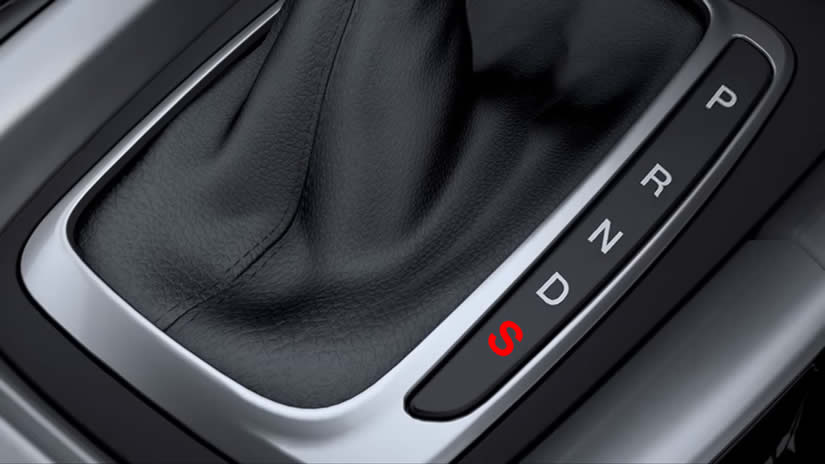Sport mode has been one of the options in automatic cars for many years. As cars have become more electronically focused, sports mode has become more sophisticated. But what is sports mode and what happens when you press the sports mode button?
What is Sport in an Automatic Transmission
When sport mode is activated, it doesn’t actually increase the horsepower of the engine, but changes the characteristics of certain vehicle components, making for a more responsive, engaging and spirited drive.
What Does the Sport Button Do?
Pressing the sport button, or shifting to ‘S’ on the gear selector lever activates sport mode. In general, sport mode works by changing the driving profile of the car from smooth and economical, to a more responsive, firmer ride.
Sport mode isn’t the same on all cars, as it depends on the technology that the vehicle is equipped with. On one car, by activating sport mode you may ask whether sports mode does anything at all, yet on another car, there may be a dramatic difference to the feel, speed and response of the car.
Here’s a list of what can happen to your car when the sport button is pressed:
- The throttle response sharpens
- Steering weight is increased
- Suspension becomes stiffer
- Gear shift pattern is changed
- Gear shift speed is increased
The Throttle Response Sharpens
For modern cars that have electronically controlled throttles, engaging sports mode makes the throttle response faster. When the driver presses the accelerator pedal, the harder the pedal is pressed, the more fuel is sent to the engine. This is a linear process, with small amounts of fuel from a light press, to larger amounts of fuel with a harder press. This helps to reduce fuel consumption and makes for a smoother drive.
When sports mode is activated, more fuel is pumped into the engine at the beginning of the pedal press, making for a more responsive, livelier engine earlier on in the accelerator pedal’s travel. This consequences of this, is faster car, but more fuel will be consumed.
Steering Weight is Increased
With modern, electronically controlled steering, steering weight, or the amount of force required to turn the steering wheel can be adjusted according to the driver’s requirements. Under normal driving, steering is light, easy to operate, but often has little feedback on how the wheels are reacting with the road.
In sports mode, the steering becomes more weighted, providing better feedback on how the road wheels are reacting with the road. This is often accompanied by a more responsive steering input.
Suspension Becomes Stiffer
If a car is fitted with electronically adjustable suspension, known as adaptive sports suspension, then it’ll change from soft and comfortable in normal driving conditions, to a much firmer drive in sport mode. This is so that the vehicle will roll less when cornering. This is at the expense of a less comfortable drive, so you’ll notice those bumps in the road a lot more.
Gear Shift Pattern is Changed
In normal driving mode (D), an automatic car’s gear shift pattern, also known as gear shift maps are designed for good fuel economy and smooth driving. The automatic transmission control shifts up gears at the earliest opportunity to optimise fuel efficiency, whilst maintaining good engine performance.
When sport mode is activated, the gear shift map is changed for one that shifts up gears later, which provides greater torque at higher RPM. This improves the vehicle’s acceleration, but will worsen fuel efficiency.
Gear Shift Speed is Increased
In normal driving conditions (D), the automatic transmission control blends reasonable engine performance, fuel economy and comfort. Slower gear changes tend to make the ride smoother and more comfortable for the vehicle occupants.
When sports mode is activated, comfort and fuel economy is exchanged for performance and speed. Every time a car changes gear, the engine loses power, the faster gear changes that occur in sport mode means the engine loses less power and maintains better performance.
Other Changes that Occur When Sports Mode is Activated
Depending on your car model, other changes that can occur when sports mode is activated is a noisier exhaust. Essentially, a flap, or valve inside the exhaust opens, allowing more exhaust noise to be emitted from the engine.
Many sports car offer the option to manually open or close the exhaust valve by a click of a button. Additionally, visual enhancements such as the dials on the dashboard cluster may change colour, often to an aggressive red tone.
What is the Point of Sport Mode?
On public roads, some drivers simply prefer their car to be more responsive, better handling and to be able to accelerate quickly when needed. Some drivers take their car off public roads and onto race tracks for track days. Sports mode will be activated and typically stability features such as Electronic Stability Control (ESC) and traction control will be deactivated.
Does Sport Mode Use More Fuel?
Depending on the car you have, activating sport mode will usually use more fuel. This is because more fuel is used to enable better acceleration and torque. Additionally, if your car is automatic, gears often change up later than usual and whilst this increases performance, it also uses more fuel.
Can you Shift from D to S While Driving?
Yes, in an automatic, while driving, shifting from D (Drive) to S (Sport Mode) is intended by all car manufacturers. By shifting from D to S, you’ll be going from normal Drive Mode into Sports Mode.
